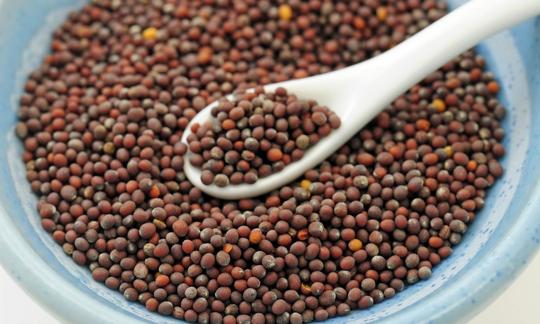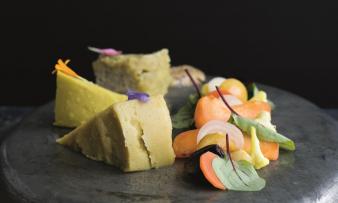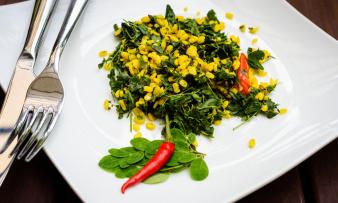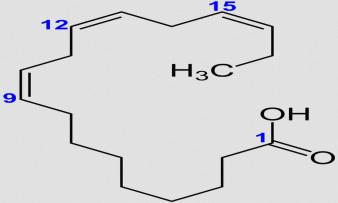Table of contents
Brown mustard seeds ( Brassica juncea (L.) CZERN. var. juncea) are the spicy-tasting seeds of the so-called Chinese, Russian, Indian or Oriental mustard. The organic seeds (brown) can be used raw as a spice.
Use in the kitchen
Brown mustard seeds have a slightly milder taste than black mustard seeds ( Brassica nigra). Overall they are less bitter 1,2 and have about 70% less spiciness than black mustard seeds. 2 Yellow-white mustard seeds ( Sinapis alba) have an even milder taste.
Whole, undamaged mustard seeds have no taste. The sharp aroma is only created by chewing, crushing or grinding the seeds and exposing them to liquid. You can find out how the typical mustard taste comes about in the "Further information" chapter below.
The seeds are used whole or freshly ground, eg with a pepper mill, mainly as a spice. 3 When roasted, they lose their spiciness and gain in aroma. As whole seeds, they are used to season curries and pickled foods. Sprouted seeds can be added to raw salads 1 and as a garnish on vegetarian or vegan dishes, for example. Freshly ground, the powder can be used to make Dijon mustard.
In India, the seed oil is one of the most important cooking oils and in Russia it is a substitute for olive oil. 3
In the Orient, the raw or cooked leaves are a popular vegetable. They have a mild peppery to spicy taste. The sweet and juicy flowers and shoots can be prepared in a similar way to the leaves or pickled in salt and vinegar. 1
Vegan mustard seed recipe for Dijon mustard
Ingredients (for one jar): 100 g brown mustard seeds (organic), 100 ml white wine vinegar, 50 ml white wine, 1 tbsp liquid honey, ½ tsp salt, 1 tbsp rapeseed oil.
Preparation: Mix all the ingredients in a blender to form a mushy paste, then leave it uncovered for half a day, stirring occasionally. This allows natural fermentation to occur. Store the mixture in screw-top jars for three weeks or longer.
Worth knowing: If you add cold water to ground grains, they become more spicy. The enzyme myrosinase acts on the glycoside sinigrin and a sulphur compound is formed. This reaction takes 10-15 minutes. If you mix the powder with hot water or, as in the recipe, with vinegar, the enzyme is inhibited and the result is mild and slightly bitter. 1
Vegan recipes with brown mustard seeds can be found under the note: " Recipes that have the most of this ingredient ".
| Not only vegans or vegetarians should read this: Vegans often eat unhealthily. Avoidable nutritional errors. |
Purchasing - Storage
Brown mustard seeds (organic) can be bought as a spice all year round. The seeds can be whole or ground ( mustard powder, mustard flour). They are available from conventional cultivation, in organic quality or in raw food quality in different packaging of 40 g, 70 g, 200 g or up to 1000 g. We recommend buying the storable mustard seeds (brown, whole), which you can grind fresh as needed.
You can find them in specialist shops, spice shops, health food stores, organic shops or delicatessens. We have not yet found the brown seeds in common supermarkets such as Coop, Migros, Spar or Interspar, Denner, Volg, Aldi, Lidl, Edeka, Billa, Rewe or Hofer or in the organic supermarket chains Denn's Biomarkt and Alnatura (according to internet research). The above-mentioned grocery stores sometimes have the yellow seeds in their range. Season: The flowering period is from June to September. 5,6 The ripe seeds are harvested in Central European countries (DA-CH) from September to October. 7
The availability of brown mustard seeds varies depending on the size of the store, catchment area, etc. If you are interested, click on our recorded food prices for the DA-CH countries (above under the ingredient image). There you will find current prices from various supermarkets and their price development.
Storage tips
Whole mustard seeds (brown) should be stored in a cool place, protected from light and moisture, otherwise they will lose their spiciness. Suitable containers are well-sealable tins or dark screw-top jars. When ground, the spice loses its aroma and color after a few months. Whole seeds have a much longer shelf life.
Found in the wild
The annual plant reaches a height of 60-100 (120) cm. 4.5 The upright stems are bristly hairy at the base and slightly branched in the upper part. 4 The slightly hairy leaves are larger and longer-stemmed in the lower part than further up. 6 The flowers are pale yellow. The 3-5.5 cm long pods contain 16-26 dark red-brown seeds. 5.6
In Europe they are occasionally found introduced or growing wild, for example in fields and rubble dumps. 6
Ingredients - Nutritional values - Calories
Here we realistically show you the ingredients of spices and herbs per 1 g (instead of per 100 g as usual).
1 g of brown mustard seeds has an energy content of 4.87 kcal. The nutritional values of mustard seeds consist mainly of 0.35 g of carbohydrates, 0.07 g of fiber, 0.25 g of protein and 0.29 g of fat. 8 The proportion of erucic acid in the seed oil accounts for more than 30% 2 and up to 57% of the total fatty acids. There are now some cultivated varieties with a low erucic acid content. 9
Worth mentioning are the levels of the amino acid tryptophan at 5 mg/1g and the fatty acid alpha-linolenic acid at 39 mg/1g. Eating 1 g of seeds covers around 2% of the daily requirement of these two nutrients.
Comparable levels of tryptophan can be found in peeled hemp seeds (6.1 mg/1g) or in driedpumpkin seeds (5.8 mg/1g). Dried porcini mushrooms contain a lot of this amino acid, at 15 mg/1g. 8
Significantly higher amounts of omega-3 fatty acids (alpha-linolenic acid) can be found in linseed (230 mg/1g), chia seeds (180 mg/1g), walnuts (91 mg/1g) or hemp seeds (87 mg/1g). The omega-6 to omega-3 fatty acid ratio in mustard seeds is approximately 1:1. 8
Secondary ingredients are glycosides, flavonoids, phenolic compounds, sterols and triterpene alcohols. 9 There are large fluctuations between the highest and lowest levels of total glucosinolates, which can rise to 200 µmol/g of seeds. 2
In Brassica juncea, sinigrin is the predominant mustard oil glycoside, which, after hydrolysis, produces allyl isothiocyanate (AITC). AITC is volatile and is responsible for the pungent taste. 2
The complete ingredients of brown mustard seeds, the coverage of the daily requirement and comparison values with other ingredients can be found in our nutrient tables. In the article Nutrients explained you will get a detailed insight into the topic.
Health effects
Are mustard seeds healthy? Scientific reviews show chemopreventive, cytotoxic, antimicrobial 10 and antioxidant ( in vitro) effects for Brassica juncea L. Allyl isothiocyanate (AITC) glucosinulate extracts confirmed in experiments that it has an antifungal effect against the growth of Aspergillus parasiticus and the production of aflatoxins (in pizza crust). Antibacterial and growth-inhibiting properties against salmonella were demonstrated on fresh chicken. Aqueous extracts were found to have inhibitory activity against staphylococci and enterobacteria in food. As part of the review, the scientists demonstrated in vitro anticancer effects of leaf extract against colon cancer and lung cancer, with future in vivo studies to support these results. 11
Dangers - Intolerances - Side effects
Brassica juncea contains the allergen 2S-albumin, which is referred to as Bra j 1 according to the WHO / IUIS Allergen Nomenclature Subcommittee. There is an increased probability that people who are allergic to brown mustard will also react sensitively to the yellow mustard. 2
Mustard seeds and mustard oils are among the foods with the highest erucic acid content. Due to the low consumption in the EU, products made from them remain the main source of intake of the harmful erucic acid. 2 Possible consequences of high consumption can be pathological changes in the heart muscle and fatty heart disease. 12
In contrast to white mustard ( Sinapis alba), no bisphenol F (BPF) was found in Brassica juncea. It is assumed that the toxic substance is formed from the glucosinolate sinalbin ( Sinapis alba), but not from sinigrin ( Brassica nigra or Brassica juncea). 2,13
Use as a recognized medicinal plant
HMPC ( Committee for Herbal Medicinal Products), ESCOP ( Association of National European Societies for Phytotherapy) and Commission E have not described Brassica juncea. The plant species is currently not an approved (well-established-use) or registered (trad. use) medicinal plant according to Section 25 Paragraph 7 AMG.
Folk medicine - natural medicine
In Australia, the seeds and leaves of Brassica juncea are traditionally used to treat pain and arthritis and rheumatism. In Pakistan, the cooking oil, together with onions, is considered a tonic. There, it is also used to treat roundworm ( Ascariasis lumbricoides) in children. In India, the leaves are used in folk medicine to lower blood sugar. Other traditional uses of the leaves and seeds are for foot pain and lumbago, as well as an emetic, 11 diuretic or stimulant. 2,11
Ecological footprint - animal welfare
The CO 2 footprint of mustard seeds depends on several factors, including the cultivation method, the country of origin and the corresponding transport and also the type of packaging. In the production of mustard seed oil, electricity consumption, fertilizer use and field emissions also had a strong negative environmental impact. 21 Despite extensive research, however, we were unable to find any precise figures on the ecological footprint of mustard seeds. The amount of water required to produce 1 kg of mustard seeds is 2809 liters. 22
The mustard plant is susceptible to a variety of pests that can cause crop losses. To prevent this, pesticides and herbicides are often used in conventional agriculture, but residues from these can also be detected in the end product. 23 Ideally, you should therefore look for organically grown products when shopping, as the use of synthetic pesticides is prohibited here.
The heat-loving plant copes well with dry and hot years. Apart from the green manure measures, it has a variety of soil-improving properties. With its branched and deep root system, it counteracts soil compaction and plays a role in soil health and soil stability. 17
Animal protection - species protection
Brassica juncea is a very attractive source of nectar and pollen for insects. 1.18 An average of 79.85 mg of nectar was found per 100 g of flowers. Pollination is carried out by bees, other insects or self-pollination. In the 2010/2011 season, 30 insect species from ten families were observed visiting the flowers. 18
Worldwide occurrence - cultivation
Brassica juncea is a cultivated plant of antiquity. Archaeological excavations have found seeds dating back to 2300 BC. According to taxonomic studies, it originated from the wild forms of Brassica rapa (turnip rape) and Brassica nigra (black mustard) in the Middle East or in neighboring areas. 14
Its natural distribution area is Asia. From 1500 AD it appears as a neophyte in Europe. 6
Possible confusion
The flowers of mustard and rapeseed look very similar, but they never bloom at the same time. Rapeseed develops its flowers in April and May and mustard flowers in summer, usually from August, less often in June or July. Another distinguishing feature is the leaves. Mustard leaves are more feathery than rapeseed leaves and have more pronounced edges than rapeseed leaves. 19
It is not a problem to confuse leaves, flowers or seeds with rapeseed, as they are non-toxic and also edible. Compared to mustard, it has the advantage that the harmful erucic acid has been bred out of today's rapeseed varieties.
Cultivation - Harvest
Brassica juncea prefers heavy but well-drained and fertile soil. It can be grown in partial shade or full sun. The plants generally grow in warmer climates than in Great Britain. They can cope with higher, stable temperatures, but not with hot climates. They are well adapted to short day lengths and tolerate high rainfall. Although they have relatively deep roots at 90-120 cm, they are not very drought-resistant. 1 Other cruciferous plants are not suitable as a crop rotation. In order to combat plant diseases, a multi-year break in cultivation should be taken. 3,15
From sowing to maturity, mustard seed plants need two to five months, depending on the variety and the time of year. 1 If sown in May, seeds can be harvested in October. The seeds can be sown all year round for leaf harvesting. The plants require regular water, but no fertilizer. 15 As a pot plant, fresh seedlings, similar to cress, can be grown from the seeds. 1 As soon as the leaves and stems have died and the pods are yellow-brown, the harvest takes place. Thermal drying by the middleman may be necessary. The average yield of Brassica juncea is slightly less than 1000 to 1400 kg/ha. Stems, leaves and roots remain in the field and serve as green manure. 16
Successful plant breeding has produced Brassica juncea species with low or no erucic acid content, which are cultivated in a few countries. 2
In countries with traditional artisanal cultivation, the harvest is done by hand and then dried in the sun for 4-10 days. In India, for example, the seed is the main product and the work involved, such as harvesting, threshing and sifting, is carried out by entire families. 3
Further information
What is mustard seed? In this article, this refers to the seeds of Brassica juncea (L.) CZERN. (var. juncea, syn.: Brassica juncea var. agrestis PRAIN or Sinapis juncea). The plant species belongs to the family of cruciferous plants (Brassicaceae or Cruciferae). It has numerous subspecies (spp.), subspecies and forms that are mainly consumed as leaf vegetables, especially in Asia.
Brown mustard is better suited to agricultural cultivation and mechanical harvesting than black mustard, 2 because it is easier to cultivate 3 and its pods are less prone to bursting. Brassica juncea is grown worldwide: in North America and Europe mainly as a spice, in India for oil production and in Asian countries (eg China, Japan) as a root and leaf vegetable. 2 In Austria, around 90% of the mustard grown is white mustard and the remaining percentage is brown and black mustard.
Whole mustard seeds have no taste when they are undamaged. The typical mustard taste and its sharpness can only be perceived when mechanical processes bring the corresponding enzymes (myrosinases) together with their substrates (mustard oil glycosides). These are spatially separated from one another in the intact plant. If the cell walls are destroyed during preparation or by chewing the plant, the enzymes and substrates come into contact with one another. This causes a chemical reaction that is accelerated by the presence of water (e.g. in saliva). The myrosinases break down the mustard oil glycosides into glucose (dextrose) and mustard oils. The latter are substances that have the typical sharp and biting taste, which in nature deters predators and protects the plant from further damage. 2 The food industry uses this effect to obtain the desired taste in mustard products. The taste and smell can also be varied, maintained for longer or intensified using water or liquids such as vinegar, milk, wine or beer. 20
Alternative names
Well-known alternative names for seeds and other plant parts are Sarepta mustard (Sarepta mustard), Indian mustard, Russian mustard, Oriental mustard, Ruten-Kohl (Rutenkohl), mustard vegetables, leaf mustard, Chinese mustard cabbage, Chinese mustard or simply mustard (brown), mustard seeds, mustard grains, mustard seed, brown mustard seeds, brown mustard, brown mustard seeds, mustard seeds (brown, whole) or brown grains. Incorrect spellings are mustard grain or mustard corn.
The English names are brown mustard, Indian mustard, Asiatic mustard, Chinese mustard, sarepta mustard or mustard seeds. In Turkish they are called hardal tohumu (mustard seeds).
Other uses
The plant parts of the mustard seed plants are also used outside of food. The seed oil is a component of hair oil or lubricant. 3 Seeds and seed residues are used as animal feed and fertilizer. 2,3 Seed meal is used as a broad-spectrum pesticide to combat nematodes, insects and fungi. 2 Plant parts are used as green manure or for the phytoremediation of lead-contaminated soils. 1
Bibliography - 23 Sources (Link to the evidence)
| 1. | Pfaf.org Brassica juncea – (L.) CZERN. |
| 2. | Lietzow J. Biologically active compounds in mustard seeds: a toxicological perspective. Foods. 2021;10(9):2089. |
| 3. | Hort.purdue.edu Brassica juncea – (L.) CZERN. |
| 4. | Bown D. Kräuter. Die grosse Enzyklopädie. Anbau und Verwendung. München: Dorling Kindersley; 2. Auflage. 2015. |
| 5. | Flora.nhm-wien.ac.at Brassicaceae / Brassica juncea. 2005. |
| 6. | Infoflora.ch Brassica juncea – (L.) CZERN. |
| 7. | Permakultur-konkret.ch Brauner Senf. |
| 8. | Diet-health.info Nährstofftabellen. |
| 9. | Rai PK, Yadav P, Kumar A, Sharma A, Kumar V, Rai P. Brassica juncea: a crop for food and health. In: Kole C, Mohapatra T, eds. The Brassica juncea Genome. Springer International Publishing; 2022:1-13. |
| 10. | Maina S, Misinzo G, Bakari G, Kim HY. Human, animal and plant health benefits of glucosinolates and strategies for enhanced bioactivity: a systematic review. Molecules. 2020;25(16):3682. |
| 11. | Salehi B, Quispe C, Butnariu M, et al. Phytotherapy and food applications from Brassica genus. Phytotherapy Research. 2021;35(7):3590-3609. |
| 12. | Krist S. Lexikon der pflanzlichen Fette und Öle. Wien: Springer Vienna; 2. Auflage. 2013. |
| 13. | Bundesamt für Lebensmittelsicherheit und Veterinärwesen BLV. Bisphenol F in Senf. |
| 14. | Banga SS, Banga S. Genetic diversity and germplasm patterns in Brassica juncea. In: Rajpal VR, Rao SR, Raina SN, eds. Gene Pool Diversity and Crop Improvement. Vol 10. Springer International Publishing; 2016:163-186. |
| 15. | Gartenjournal.net Müller S. Senf anbauen ganz einfach. |
| 16. | Landschafftleben.at Senfanbau, Pflanzenschutz und Ernte. |
| 17. | Steirersaat at. Anbauanleitung Brauner- orientalischer Senf. 2021. |
| 18. | Bienen-nachrichten.de Wann suchen Bienen Senfblüten auf? 2016. |
| 19. | Gartenjournal.net Senfpflanze und ihr Unterschied zum Raps. |
| 20. | Uhl SR. Handbook of Spices, Seasonings and Flavourings. Lancaster: Technomic Publishing Company; 2000:132-6. |
| 21. | Khatri P, Jain S, Pandey S. A cradle-to-gate assessment of environmental impacts for production of mustard oil using life cycle assessment approach. Journal of Cleaner Production. 2017; 988-997. |
| 22. | Mekonnen MM, Hoekstra AY. The green, blue and grey water footprint of crops and derived crop products. Hydrol. Earth Syst. Sci. 2011; 15: 1577-1600. |
| 23. | Choudhary A, Sharma DC. Dynamics of pesticide residues in nectar and pollen of mustard (Brassica juncea (L.) Czern.) grown in Himachal Pradesh (India). Environ Monit Assess 144. 2008;143–150. |










Comments